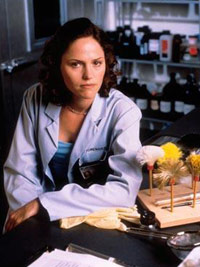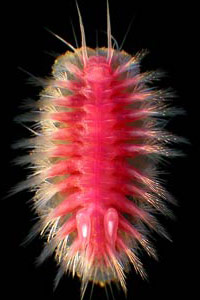
On this page, you'll find regularly updated audio, video, and text reports from our producers and correspondents. We invite you to join the discussion about topics covered here on our board and to subscribe to our audio and video podcasts to download these reports to your computer or MP3 player.

A microscope photo shows eight of the cloned embryos that were big news at last year's AAAS conference. 
The "CSI Effect" has its pros and cons. Pro: More women, perhaps seeking to emulate the CSI character played by Jorja Fox, above, are studying forensic science. Con: Criminals are taking notes. 
And, for the category of Best Name for a New Species, the winner is...the bone-eating zombie worm. |
3.7.2005 Searching for StoriesIf you ask me, my job is among the most fun—and sometimes the most frustrating—of anyone's here at NOVA scienceNOW. As the development producer, I constantly scan for new story ideas. I'm set loose to explore the things I find interesting, and to do just enough reporting to convince my bosses that we've got a solid story that should go on the air. Then I move on to the next thing. This means keeping an eye on breaking news, and talking with scientists about the most interesting still-unanswered questions they are tackling in various fields. It also means occasionally feeling overwhelmed both by the towering piles of journals and magazines on my desk, and by all the things I don't know. At the end of February, I attended the five-day annual meeting of the American Association for the Advancement of Science (AAAS), held this year in Washington, D.C. The AAAS publishes the almighty journal Science, and if there's one meeting that provides a good overview of hot scientific topics in a variety of fields, this is it. In a maze-like Marriott filled with conference rooms and ballrooms, scientists and science journalists packed rows of tightly squeezed chairs to watch PowerPoint presentations and listen to panel discussions and lectures from 8 in the morning 'til nearly 8 at night. There were separate news briefings just for the media throughout the day, where a stern-lipped matron stood at a raised podium, scanning the crowd as if daring us to shuffle our feet too loudly and controlled the question and answer sessions with military precision. We behaved. Sometimes this is where major news gets announced. At last year's meeting, South Korean scientists revealed that they had—for the first time in history—successfully created a cloned human embryo and derived stem cells from it. This year, there were no such fireworks. A comment I overheard as two fellow journalists passed me in the hallway was typical. "It's interesting," one was saying to his friend about whatever they had just learned. "But it's not a story." Definitely interesting, however. We got an update on the Mars rovers, for example, and the search for evidence of water in that planet's history, in a dynamic plenary lecture by Steve Squyres of Cornell University. Up on stage, he paced and gesticulated like a masterful tent preacher or a rock star—an effect enhanced by three huge video screens flanking him, which projected him many times larger than life for the benefit of worshipers in the back rows. And, as is its annual tradition, National Public Radio's "Talk of the Nation: Science Friday," hosted by Ira Flatow, broadcast live from the conference. While discussing the public's understanding of science, Flatow noted that in a 2001 study by the National Science Foundation, two-thirds of the public admitted that they don't understand the scientific process. Only slightly more than half knew how long it takes the Earth to go around the sun. And, as Melissa Pollak of the NSF pointed out, the upsurge in belief in evolution that the survey recorded in 2001 "turns out was probably a blip," given more recent data. There were also evening events, including a physics gala at which—one colleague informed me—actors were going to dress up as famous physicists from the past. I peeked in at one point and spotted a guy who had been walking around in a huge white Einstein wig all day. So, what follows is a brief, and by no means comprehensive, description of my favorite sessions. You'll have to watch upcoming episodes of our show (the next one is on April 19, 2005) to find out which ones we think are "stories." What it Takes to Make an AIDS VaccineThe government's top HIV expert, Anthony Fauci of the National Institute of Allergy and Infectious Diseases, and Seth Berkley of the International AIDS Vaccine Initiative, described today's leading vaccine candidates—and the research hurdles yet to be overcome. A new vaccine candidate has just entered efficacy trials in humans (after two others have failed). But, "Don't associate my name with the word 'breakthrough,'" Fauci told us. "The trial that's started is a trial that's started. We have no idea what's going to happen." Uniformly, all of the current vaccine candidates rely on "cellular immunity," which means that they rally the body's immune cells to destroy cells infected with HIV—an approach that has serious limitations. Namely, you have to be infected before cellular immunity can launch a response. This helps prevent the spread of infection, but doesn't prevent infection in the first place. The ultimate goal is a vaccine that causes the body also to produce antibodies against the HIV virus: antibodies, which can neutralize HIV before it starts infecting cells. Dr. Fauci emphasized that we probably won't have a truly preventative vaccine until we have one that produces neutralizing antibodies along with cellular immune responses. That Nasty Bird FluAlso on the topic of viruses, Nancy Cox, the chief influenza scientist at the Centers for Disease Control and Prevention, warned of a global epidemic from a bird flu virus if one of the strains now incubating in ducks and other poultry in Asia should mutate to become as deadly—and to pass from person to person as easily—as the viruses that killed millions during three major influenza pandemics of the 20th century. The Honeymoon Is OverOn a lighter note, real-life crime scene investigators are no longer amused by the wild popularity of the CBS television series "CSI: Crime Scene Investigation." In one session, forensic scientists griped about the "CSI Effect," which Max Houck of West Virginia University described as "the perception of near infallibility of forensic science after watching a few episodes of CSI." True, the show has had some positive impact on the field. Enrollment in forensic science programs has skyrocketed, for example. At Houck's university, just four students out of a student body of 25,000 graduated as majors in forensic science in 1999. Today, 400 students are in the program. The vast majority of them are women, making this the single-largest major on campus and a novel nexus for women in science. There is a downside, however, to the CSI Effect. Jurors and the relatives of crime victims now express disappointment when their cases do not trigger high-tech detective work—which in many cases is not necessary. And they have an unrealistic vision of how fast tests can be run and crimes can be solved (like, within a network hour). Prosecutors, too, are demanding more tests than ever, which adds to the backlog at the nation's forensic laboratories. And some experts have apparently stopped contributing ideas to the television show, since criminals, too, have been watching and taking tips about what NOT to do in order not to get caught. Oddly enough, a speaker following Houck then proceeded to play lengthy clips from an episode of CSI, and to use them, without irony, to describe the steps forensic scientists take when investigating a case. Worth a Thousand Words?Sometimes it's unfortunate that seeing is believing. Joseph Dumit of MIT gave a fascinating talk about the way in which brain imaging can be misused. His most compelling example came from a poster put out by the National Institute on Drug Abuse, which was part of its club drug campaign. On the left, it showed a brain image taken from someone who had never done the club drug Ecstasy, and on the right the brain of an Ecstasy user. To the casual viewer, differences jump out immediately, including an ominous dark patch in the forebrain of the drug user. This is proof that drugs are dangerous, right? Wrong. What NIDA didn't reveal is that those images were taken at different levels in the brain, and do not show comparable structures. Plus, the poster's creators took a certain amount of artistic license, inverting the color scheme on the left side of the poster versus the right. In other words, things that would appear blue on one side appear black on the other—making the "Ecstasy" brain look even more different from the "plain" brain. Best Name for a New SpeciesSeveral scientists gave fascinating presentations about the hidden lives of whales. This includes what happens when they die and sink to the bottom of the ocean. Craig Smith of the University of Hawaii talked about stumbling across science's first so-called "whale fall" off the coast of California with the submersible vehicle ALVIN in 1987. After scavengers such as sharks and hagfish reduce the dead whale to mere bones, worms and crustaceans colonize and feed on the lipids in the bones, including the colorfully named "bone-eating zombie worm" discovered by scientists off the coast of Monterey, California last year. In a third stage of colonization, species move in that thrive on sulfides as the bones degrade anaerobically. Whale falls support the highest concentration of species ever seen in the deep sea, and the ecosystem can persist for 70 or 80 years. All told, there are approximately 30 species that seem to exist only on dead whales, and the loss of "habitat" caused by whaling may have caused the first-ever extinctions in the deep-sea environment. Whaling has reduced the North Atlantic whale fall habitat by 75 percent, Smith said, which could in turn drive a third of whale fall-dependent species to extinction. Even whaling at a more sustainable level of 50 percent could cause 15 percent of these species to disappear. To perpetuate the ecosystem for study, scientists have actually started grabbing whales that have beached themselves and died, and hauling them out to sea, where they sink them to the dark seafloor. They have given this process the rather humorous name of "whale implantation experiment." Smith showed video taken underwater by scientists in which a shark, chowing down on rotting whale flesh, appears to mug for the camera. "Look...this shark is about to turn to the camera and smile, he likes it so much!" Smith announced, amused. (I think Mikey would stick to Life cereal, however.) More That Cousteau Never Knew About WhalesMarine biologist Steve Palumbi of Stanford University has a different approach to studying whales. He is famous for his genetic analysis of DNA found in whale meat bought in Japanese grocery stores. The goal of his recent studies was to build a family tree for whales, thereby solving some important riddles about the abundance of Antarctic minke whales over time, and about their effects on other whale species. His talk was accompanied by pictures of scientists in their Tokyo hotel rooms, doing laboratory analysis with portable machines while wearing Japanese robes. Palumbi's data refute Japan's claims that today's population of minkes is abnormally high, and that minkes threaten the recovery of other endangered species—such as the blue whale—by competing for food. Japan has used this argument to justify its calls for resuming the commercial hunting of minke whales. (Full-scale commercial whaling was suspended in 1986, when the plunging numbers of many species caused the International Whaling Commission to declare a moratorium.) The data show that the minke population has been remarkably stable over time and resilient to climate change—staying strong throughout the various ice ages. Palumbi's analysis also reveals that Antarctic minke whales may be the longest surviving whale population on Earth. He was able to trace their origin back one million years to a single minke "mitochondrial Eve." Mapping our DNAThere was progress in the effort to understand our own DNA as well. In a step toward one day offering gene-based customized medicine, scientists from California's Perlegen Sciences, Inc. released the first, partial map of common human genetic variations—patterns of DNA differences that may someday help diagnose people's risk of disease and the treatments best suited to them. Einstein@Home2005 is the "World Year of Physics," and Einstein, who died exactly 50 years ago, was on everyone's mind. One prediction of Einstein's general theory of relativity is that certain events in space, such as the cataclysmic collision of two black holes, or two neutron stars orbiting each other, ought to create distortions in spacetime that propagate through space. These are called gravity waves. But while they were predicted as early as 1916, not a single gravity wave has yet been detected. The reason? We haven't had a sensitive enough detector. Hence a project called LIGO: the Laser Interferometer Gravitational-Wave Observatory. This is not only the most sensitive detector ever built, which can detect distortions in space on the order of a thousandth of the diameter of a hydrogen atom. It is also the recipient of the largest amount of money that the National Science Foundation has ever spent on a single project. If you're interested, there's a way that you can get involved in analyzing data from LIGO. It was announced at the conference by Barry Barish of the California Institute of Technology, the director of LIGO, and is called "Einstein@Home." (P.S. It comes with a cool screen saver.) Coolest Use of Cosmic Radiation
The threat of terrorists detonating a nuclear device in a major U.S. city has
inspired research aimed at providing better border surveillance for illicit
nuclear material. Christopher Morris and Rick Chartrand of Los Alamos National
Laboratory described a new application for the charged subatomic particles
known as cosmic-ray muons that shower down on us from space at every moment.
They scatter more widely when they hit dense materials, such as lead, than when
they hit other materials. And lead is often used to shield nuclear weapon
materials like uranium. In a clever move, Los Alamos scientists have figured
out how to use muon scattering patterns to detect radioactive material in a
shipment of normal cargo. What's intriguing about this technique is it requires no
extra radiation, avoiding the risk and expense of generating X-rays, gamma
rays, etc. Just roll a truck through a detector and let the natural radiation
from space do all the work.
|
|||||||||||

Kyla Dunn is the development producer at NOVA scienceNOW, and co-produced the series' piece on stem cells and cloning. Her work on these topics has appeared on the cover of The Atlantic Monthly, in The Washington Post "Outlook" section, and on PBS's Frontline. Her Atlantic Monthly piece, "Cloning Trevor," won the National Association of Science Writers' Science-in-Society Award in 2003. |
||||||||||||
|
© | Created March 2005 |
||||||||||||
